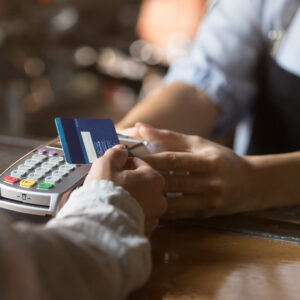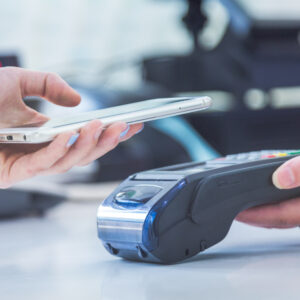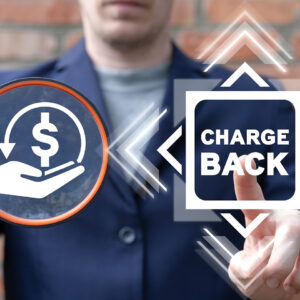Back in April of 2020, during the early days of the pandemic, a study in the U.S. revealed that 52% of consumers said they would stick to their new digital grocery shopping methods after the crisis ended.[1] As we close out 2021, trends toward safety, efficiency, and personal service show no signs of slowing down. Already we’ve seen both quick service and fast casual restaurants, in addition to higher end, dine-in restaurants, adapt to new regulations and consumer behaviors faster than most industries.
Digitalization was already growing prior to the pandemic. Now it is skyrocketing. Customers are seeking alternative ordering and payment methods. This includes AI-enabled self-service kiosks, pay-at-table, and mobile apps that offer ease of use and a more personal experience.
The Digital First Economy For Food and Beverage Moving Forward
A new report from PYMNTS shows that since March of 2020, a digital-first economy has emerged and has fundamentally changed how restaurants engage with their guests. In this new economy, remote ordering and off-site dining now represents the majority of the food and beverage industry’s orders. Sixty-seven percent of average restaurant sales generated by orders placed digitally or by phone for off-premises dining.
According to the report, the growing importance of remote orders reflects the broader, fundamental, post pandemic shift as ecommerce becomes a more critical component to consumers’ lives. Simply put, the ways in which consumers engage with restaurants and their types of food ordering experiences have changed. These digital consumers want restaurants to accommodate their growing need for quick, smooth, convenient, and often contactless, transactions across the board.
Remote food orders are now responsible for most of the average restaurant’s revenue, but the extent to which restaurants rely on remote versus on-site sales varies with the type of restaurant in question. Sit-down restaurants generate more in-person sales than QSRs, for example. Food orders placed and eaten on-site generate 40% of the average sit-down restaurant’s total sales but just 25% of the average QSR’s total sales, according to the report. This underscores just how important digital food sales have become since the pandemic first began.
The report also found that not all remote ordering channels are created equal. Online orders now account for at least 40% more revenue than phone orders for the average restaurant. Just 28% of total restaurant sales are now generated by orders placed via phone call. Aggregators alone now generate 16% of the average restaurant’s revenue. Mobile order-ahead is not far behind, however, totaling 14% of the average restaurant’s revenue.
Other key findings included:
- Remote food orders are now restaurants’ primary source of revenue. The average QSR now generates as much as 75% of its sales from orders made online or over the phone. Online orders account for over 40% more revenue than phone orders to the average restaurant, and aggregators drive more revenue than any other digital ordering channel.
- Remote versus on-site sales varies with the type of restaurant. QSRs generate more off-premises sales than sit-down restaurants. Food orders placed and eaten on-site generate 25% of the average QSR’s total sales but 40% of the average sit-down restaurant’s total sales.
- Remote orders vary by channel. The average restaurant now generates 16% of its total sales via aggregator, 14% of its sales via mobile order-ahead, and 10% of its sales via desktop website. This shows that restaurants have an opportunity to maximize conversion by providing an abundance of online ordering options.
“The digital-first food ordering habits that consumers have acquired since March 2020 have fundamentally changed the restaurant industry. The brick-and-mortar restaurant is no longer the focal point of consumers’ dining experiences but a single touch point in a much broader, decentralized and digital-first ecosystem. Restaurants have come to understand that providing digital ordering features is key to delivering their customers the food ordering experiences they want when they want them, but some restaurants have yet to realize that digital ordering features are the price of admission in this new market — not a differentiator.”
Convenience is Crucial
Contactless payments may have surged out of necessity. But as their usage increased, customers have come to realize how much more convenient they are. Consider the increasingly popular curbside pickup – one US survey found that 40% of customers have increased their use of curbside pickup for restaurants.[2] Other market research has also discovered that digital and delivery orders have increased to 65%, despite a 25% decline in traffic.[3]
Contactless payments is also now a driver of customer loyalty. In a survey of over 25,000 consumers globally, 54% prefer contactless payment methods and 23% want restaurants to use technology to improve the experience, according to the Ayden Retail Report, 2020.
Touch-free technology not only attracts customers but increases loyalty. QR codes in particular are seeing a resurgence. Their versatility allows restaurants to use them for a variety of interactions – from menus and membership programs to payments and contact tracing.
The takeaway? Customers will shift to pathways that offer them the highest level of convenience. But to implement this model, restaurants need an integrated solution for accepting all forms of digital payments.
Ownership of the delivery process is also important. Another survey showed that 4 in 10 respondents would blame the restaurant for a poor delivery experience – even if it was through a third-party app.[4] Whether this is achieved through restaurants deploying their own delivery service or through delivery service providers like Uber Eats, they must shoulder responsibility for the end-to-end process.
Four Considerations Critical To Success
So what’s a restaurant to do? One solution is to implement a system that can help manage payments, inventory, menu options, and labor. With a single overarching system in place, food and beverage businesses can quickly identify the most optimal areas for boosting their efficiency (e.g. by speeding up new hire onboarding). This solution should of course also be able to support the various contactless payment options.
Here are four critical considerations any food and beverage business should to consider when it comes to payment processing systems and processes:
1. Be POS Agnostic
Ensure your payment processing solution is POS agnostic so your business can integrate with the systems, and resulting processes, of choice, thereby streamlining operations so you can provide a more fluid, customer-centric experience.
2. Ensure Your Payment Processing Can Support Any Food and Beverage Business Model
A POS system should fit your business model. From countertop and tablet-based apps to wireless pay-at-the-table models, implement a secure and affordable solution to propel your business forward, ensuring you provide a payment process that matches your business.
3. Ironclad Security For A Digital World
Security in a post pandemic world has never been more important. Ensure your customers’ data will be safeguarded by leveraging the most up-to-date payment security that is PCI compliant and validated with point-to-point encryption.
4. Up-To-Date Technology
The restaurant industry is always changing and evolving, especially after what it’s endured the past year and with the ongoing pandemic. While some well-established restaurants may be hesitant to let go of the tools and processes they’ve been using since their inception, to stay competitive in a crowded industry, providing customers and employees with the best solutions should be a priority.
Use a cutting-edge POS and payments system that frequently releases new features and updates old ones. Utilizing the most up-to-date technology streamlines your operations and gives more time back to your employees to focus on their jobs of serving your customers. After all, word of mouth and customer reviews are among the top ways for restaurants to attract new customers and improve loyalty among existing customers.
Sources:
1 https://www.pymnts.com/today-in-data/2020/consumer-life-in-a-post-covid-19-economy/
2 https://www.qsrweb.com/blogs/is-mobile-solving-the-wait-time-problem-for-restaurant-brands/
3 https://www.fastcasual.com/blogs/restaurants-cant-afford-to-avoid-contactless-tech/
4 https://www.fastcasual.com/blogs/poll-reveals-3-things-customers-want-during-covid-19/







